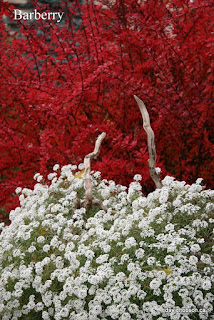As usual, fall has been a blaze
of colour with three-alarm fires everywhere. The hottest, brightest flames on
show were most likely Euonymus alatus, appropriately named the burning bush.
There's a grouping of them near the train station in Waterloo that were amazingly
bright.
I have a Euonymus alatus in my
garden. It is not ablaze. The best it has ever done is smoulder like a wet
campfire on a May 24 weekend. It's one of the first shrubs I planted in my
garden and it's been somewhat disappointing.
 In the early days, old alatus flared up
occasionally, but over the years it's never achieved the same fiery luminosity
of others in my neighbourhood. Even now, after a brilliant fall, most of the
leaves are a dull green, and the ones that have changed colour only look as
though someone spilled cheap red wine on them. In fact, I should take a closer
look as we did have a birthday party around here last week, but I didn't think
the wine was that bad. No, my burning bush has been a disappointment. Dull,
dull, dull.
In the early days, old alatus flared up
occasionally, but over the years it's never achieved the same fiery luminosity
of others in my neighbourhood. Even now, after a brilliant fall, most of the
leaves are a dull green, and the ones that have changed colour only look as
though someone spilled cheap red wine on them. In fact, I should take a closer
look as we did have a birthday party around here last week, but I didn't think
the wine was that bad. No, my burning bush has been a disappointment. Dull,
dull, dull.
Despite being a failure in my
garden as the self-actualizing arsonist of the plant world, it has fulfilled
other roles reasonably well, providing a pleasant green backdrop to summer
flowering plants, while maintaining balance with other shrubs and trees nearby.
But it mainly filled a gap, and
a gap filler is not what I need when I'm running out of space for new plants.
This is why I've been slowly coming around to the realization that the burning
bush has to go. I can't blame it for the lack of colour change. Fifteen years ago
it was in sunshine, but now the shrubs and trees in that corner of the garden dwarf
it, and consequently it's in almost full shade, which I suspect is one reason why
it doesn't burn brightly, although I've seen others that do well without full
sun.
 My mind is almost made up. It
has to go. I just have to bring myself to do it. There's no denying that Euonymus
alatus is a good, easy to grow, trouble-free shrub. So trouble free and easy to
grow, in fact, that it's become an invasive pest in milder US states like
Connecticut or Virginia. Don't let this deter you from planting your own if you
have a bright place for one. Around here, the winters are cold enough that it
stays firmly put.
My mind is almost made up. It
has to go. I just have to bring myself to do it. There's no denying that Euonymus
alatus is a good, easy to grow, trouble-free shrub. So trouble free and easy to
grow, in fact, that it's become an invasive pest in milder US states like
Connecticut or Virginia. Don't let this deter you from planting your own if you
have a bright place for one. Around here, the winters are cold enough that it
stays firmly put.
It grows well in most
conditions and tolerates different soils, but isn't crazy about wet conditions.
It can handle being in shade, albeit with subdued fall colour, and pests are
rarely a problem. A natural vase-shape makes it an attractive specimen plant, yet
it can also be grown and pruned as a hedge. Other names for the burning bush
are winged euonymus, winged wahoo, or winged spindle-tree.
Take a closer look
at the next one you see and you'll understand why. The small, corky, wing-like
protrusions along the stems become obvious after the leaves have fallen, making
it an interesting plant for the winter garden. Darn, now I'm wavering again. (Update -- the burning bush went, hence the Barberry added).
No comments:
Post a Comment